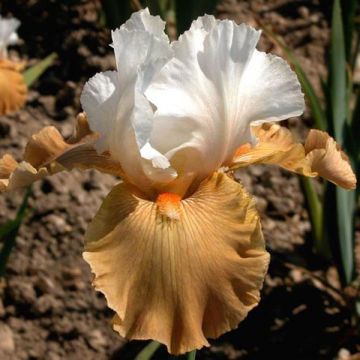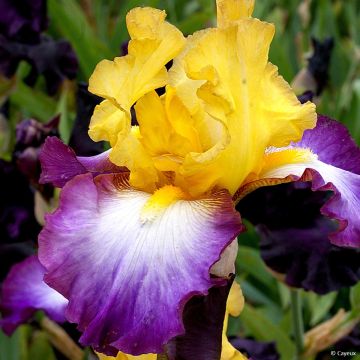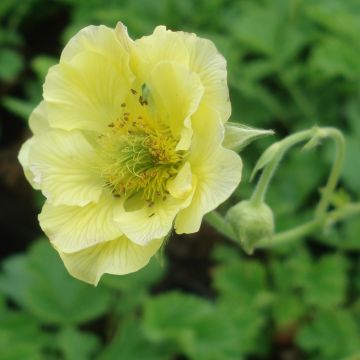

Iris Sharper Image - Tall Bearded Iris
Iris Sharper Image - Tall Bearded Iris
Iris germanica Sharper Image
German Iris, Bearded Iris
Special offer!
Receive a €20 voucher for any order over €90 (excluding delivery costs, credit notes, and plastic-free options)!
1- Add your favorite plants to your cart.
2- Once you have reached €90, confirm your order (you can even choose the delivery date!).
3- As soon as your order is shipped, you will receive an email containing your voucher code, valid for 3 months (90 days).
Your voucher is unique and can only be used once, for any order with a minimum value of €20, excluding delivery costs.
Can be combined with other current offers, non-divisible and non-refundable.
Home or relay delivery (depending on size and destination)
Schedule delivery date,
and select date in basket
This plant carries a 12 months recovery warranty
More information
We guarantee the quality of our plants for a full growing cycle, and will replace at our expense any plant that fails to recover under normal climatic and planting conditions.
Would this plant suit my garden?
Set up your Plantfit profile →
Description
Iris 'Sharper Image' (TB) is a tall variety of bearded iris with large flowers between mid and late spring. They are perfectly balanced and illuminate flower beds with their immaculate snow white, barely speckled with pale lavender. The plant rapidly develops into lush clumps that flower in beds and borders for a few weeks.
Iris 'Sharper Image' is a rhizomatous, deciduous perennial plant, with vigorous upright clumps. It belongs to the Iridaceae family, like Crocus, Gladiolus, or Crocosmia. Iris germanica, commonly known as bearded or German iris, is probably the result of hybridization between different botanical species. It belongs to the bearded iris group (due to the fine crest present on the sepals) and is the most commonly grown in gardens.
Sharper Image is a tall variety that reaches 105 cm (41in) high when flowering, with a strong floral stem supported by a rhizome and bearing numerous flower buds. The clump spreads rapidly, becoming as wide as it is tall, or even wider, with the central rhizomes becoming bare in favour of the outer rhizomes. The foliage consists of long, slightly arched sword-shaped, glaucous green leaves, arranged in a fan. Large floral stems appear in April which bloom in May or June depending on the climate, with large flowers measuring 12-14 cm (5-6in) wide that open from the top to the lower branches. They are pure white and formed by 3 sepals that stretch almost horizontally, topped by 3 upright petals that hide the style (female reproductive part). The sepals have a short pastel lavender beard at their base, and their surface has wavy edges, the vertical petals are pleasantly crinkled. Their silky texture is particularly attractive and ornamental.
Obtained by Black in 2005.
Awards: Honorable Mention in 2007, Award of Merit in 2010.
Iris are easy to associate with other plants. Just keep in mind that you will need to divide the clumps every 3 or 4 years, so leave enough available space. By associating early-blooming Iris with Sharper Image, you can spread the flowering season over about 2 months, beyond that, the choice is endless. Oenothera speciosa 'Twilight' or Evening Primrose is a low-growing perennial happy in well-drained soils and sunny exposures that Iris love and from June to September, it produces pretty pale pink flowers that will take over from your Iris. Gaura, in its many varieties with small airy white, pink, or almost red flowers, will also be a perfect companion. Daylilies will also extend the flowering season, Amadeus is a very beautiful deep red variety that will spice up your mixed flower bed!
Flowering
Foliage
Plant habit
Botanical data
Iris
germanica
Sharper Image
Iridaceae
German Iris, Bearded Iris
Cultivar or hybrid
Other German Iris - Bearded Iris
View all →Planting and care
Do you have a very sunny location, dry in summer?
This is the ideal location for irises! In the shade, they grow but do not flower. They are hardy and do not need winter protection. Well-drained soil is perfect, even dry and chalky, or stony. Too much moisture in the soil promotes rhizome rot. Plant from July to September to give the rhizomes enough time to grow and develop new roots before winter. They should be planted as soon as they are purchased for the best results. Plan to divide the irises every 4 years or so to give them fresh soil and start over with new rhizomes. This prevents the clumps from thinning out in the centre. They are vigorous and require space to develop and flower well. Planted with a spacing appropriate for the size and vigour of the variety: about 34-50 cm (13-20in) for the tall ones. Always consider the direction of growth of the rhizomes by arranging them in a star shape, with buds and leaves facing outward, and spacing them well away from other varieties so they have room to grow.
Planting
Dig a hole that is wide and deep enough. Make a conical pile of soil in the hole and place the rhizome and spreading roots on top. Cover the roots. It is important that the rhizome is level with the surface of the soil. It should not be planted in a dip (risk of rot), so take into account that the soil will settle and the iris will sink. In clayey or damp soil, the rhizome can even be raised on a slight mound. To make the soil cling to the roots, lightly firm and water abundantly immediately after planting. Water 2-3 times if necessary until established.
Maintenance:
Keep the soil free of weeds by shallow hoeing, taking care not to damage the rhizomes or roots. Weeds shade the irises, retain moisture (rotting), and attract slugs. Similarly, remove dry leaves. If they are diseased (reddish-brown bordered spots of heterosporiosis), we recommend burning them. Remove faded flowers.
Planting period
Intended location
Care
Planting & care advice
This item has not been reviewed yet - be the first to leave a review about it.
Similar products
Haven't found what you were looking for?
Hardiness is the lowest winter temperature a plant can endure without suffering serious damage or even dying. However, hardiness is affected by location (a sheltered area, such as a patio), protection (winter cover) and soil type (hardiness is improved by well-drained soil).

Photo Sharing Terms & Conditions
In order to encourage gardeners to interact and share their experiences, Promesse de fleurs offers various media enabling content to be uploaded onto its Site - in particular via the ‘Photo sharing’ module.
The User agrees to refrain from:
- Posting any content that is illegal, prejudicial, insulting, racist, inciteful to hatred, revisionist, contrary to public decency, that infringes on privacy or on the privacy rights of third parties, in particular the publicity rights of persons and goods, intellectual property rights, or the right to privacy.
- Submitting content on behalf of a third party;
- Impersonate the identity of a third party and/or publish any personal information about a third party;
In general, the User undertakes to refrain from any unethical behaviour.
All Content (in particular text, comments, files, images, photos, videos, creative works, etc.), which may be subject to property or intellectual property rights, image or other private rights, shall remain the property of the User, subject to the limited rights granted by the terms of the licence granted by Promesse de fleurs as stated below. Users are at liberty to publish or not to publish such Content on the Site, notably via the ‘Photo Sharing’ facility, and accept that this Content shall be made public and freely accessible, notably on the Internet.
Users further acknowledge, undertake to have ,and guarantee that they hold all necessary rights and permissions to publish such material on the Site, in particular with regard to the legislation in force pertaining to any privacy, property, intellectual property, image, or contractual rights, or rights of any other nature. By publishing such Content on the Site, Users acknowledge accepting full liability as publishers of the Content within the meaning of the law, and grant Promesse de fleurs, free of charge, an inclusive, worldwide licence for the said Content for the entire duration of its publication, including all reproduction, representation, up/downloading, displaying, performing, transmission, and storage rights.
Users also grant permission for their name to be linked to the Content and accept that this link may not always be made available.
By engaging in posting material, Users consent to their Content becoming automatically accessible on the Internet, in particular on other sites and/or blogs and/or web pages of the Promesse de fleurs site, including in particular social pages and the Promesse de fleurs catalogue.
Users may secure the removal of entrusted content free of charge by issuing a simple request via our contact form.
The flowering period indicated on our website applies to countries and regions located in USDA zone 8 (France, the United Kingdom, Ireland, the Netherlands, etc.)
It will vary according to where you live:
- In zones 9 to 10 (Italy, Spain, Greece, etc.), flowering will occur about 2 to 4 weeks earlier.
- In zones 6 to 7 (Germany, Poland, Slovenia, and lower mountainous regions), flowering will be delayed by 2 to 3 weeks.
- In zone 5 (Central Europe, Scandinavia), blooming will be delayed by 3 to 5 weeks.
In temperate climates, pruning of spring-flowering shrubs (forsythia, spireas, etc.) should be done just after flowering.
Pruning of summer-flowering shrubs (Indian Lilac, Perovskia, etc.) can be done in winter or spring.
In cold regions as well as with frost-sensitive plants, avoid pruning too early when severe frosts may still occur.
The planting period indicated on our website applies to countries and regions located in USDA zone 8 (France, United Kingdom, Ireland, Netherlands).
It will vary according to where you live:
- In Mediterranean zones (Marseille, Madrid, Milan, etc.), autumn and winter are the best planting periods.
- In continental zones (Strasbourg, Munich, Vienna, etc.), delay planting by 2 to 3 weeks in spring and bring it forward by 2 to 4 weeks in autumn.
- In mountainous regions (the Alps, Pyrenees, Carpathians, etc.), it is best to plant in late spring (May-June) or late summer (August-September).
The harvesting period indicated on our website applies to countries and regions in USDA zone 8 (France, England, Ireland, the Netherlands).
In colder areas (Scandinavia, Poland, Austria...) fruit and vegetable harvests are likely to be delayed by 3-4 weeks.
In warmer areas (Italy, Spain, Greece, etc.), harvesting will probably take place earlier, depending on weather conditions.
The sowing periods indicated on our website apply to countries and regions within USDA Zone 8 (France, UK, Ireland, Netherlands).
In colder areas (Scandinavia, Poland, Austria...), delay any outdoor sowing by 3-4 weeks, or sow under glass.
In warmer climes (Italy, Spain, Greece, etc.), bring outdoor sowing forward by a few weeks.



























































